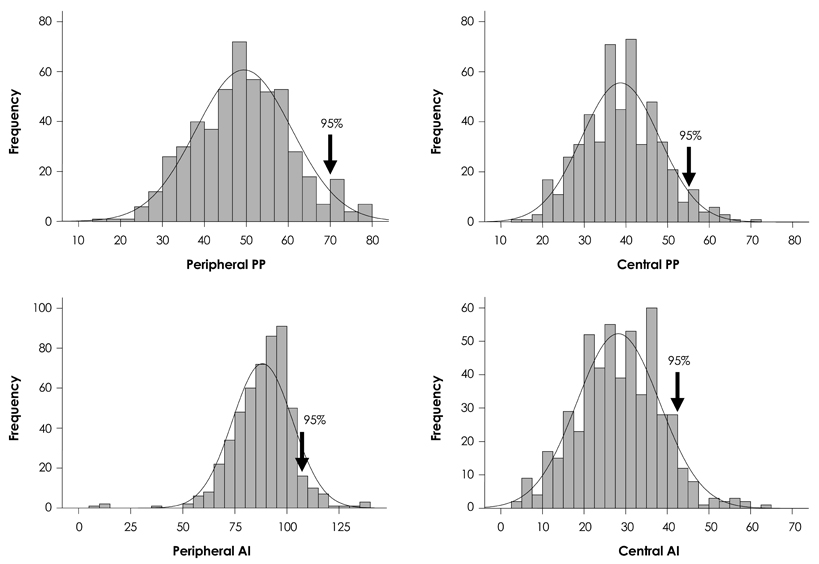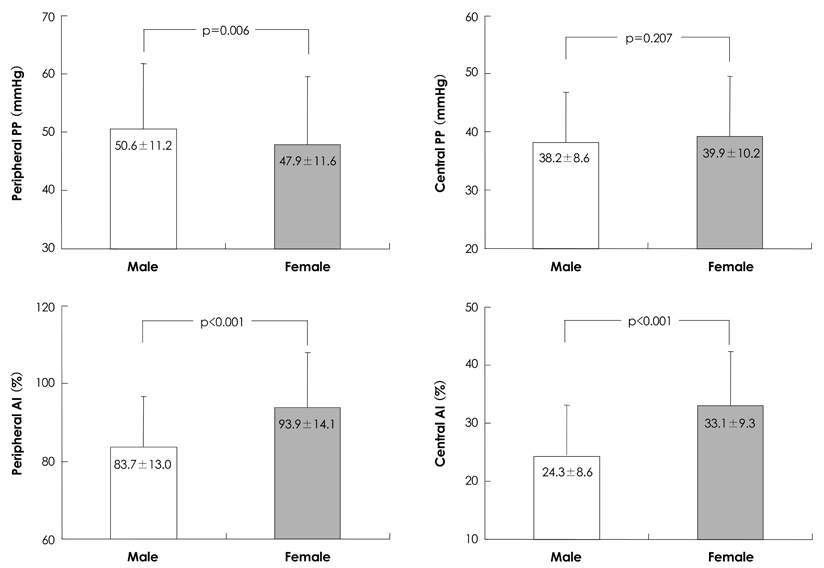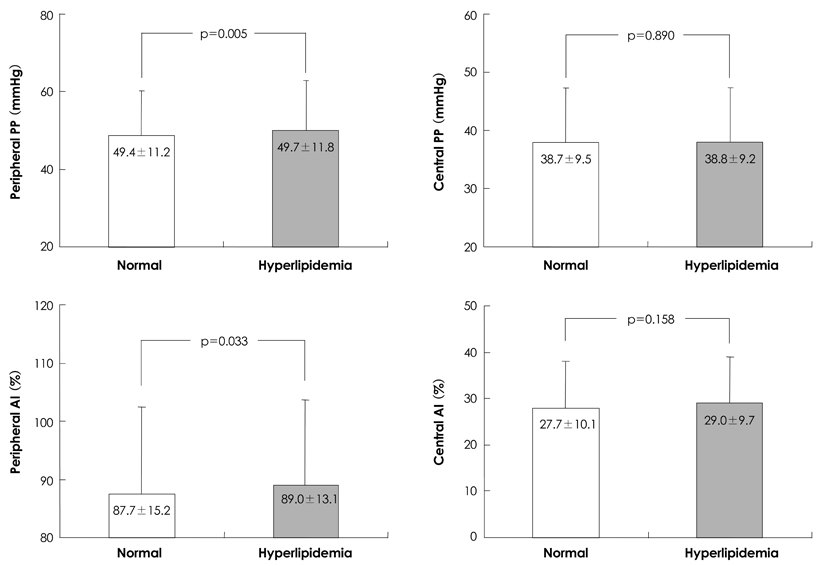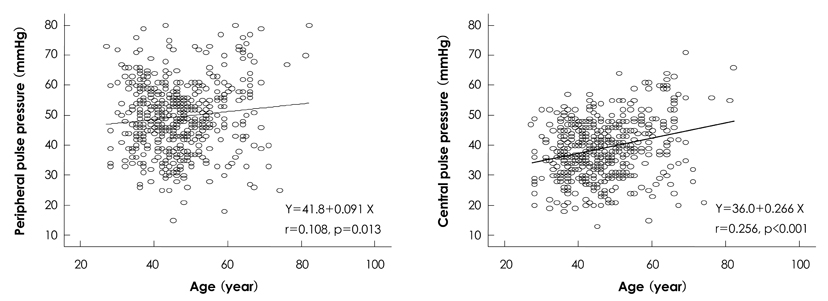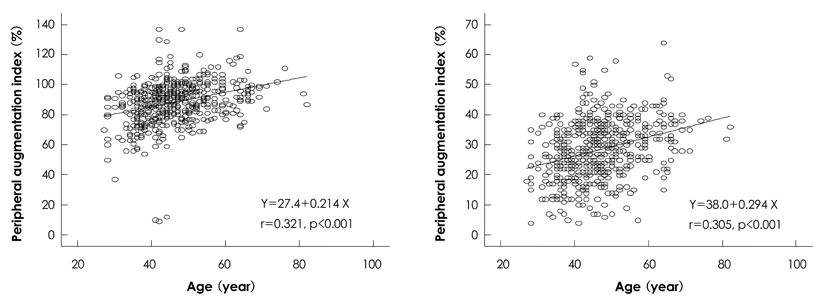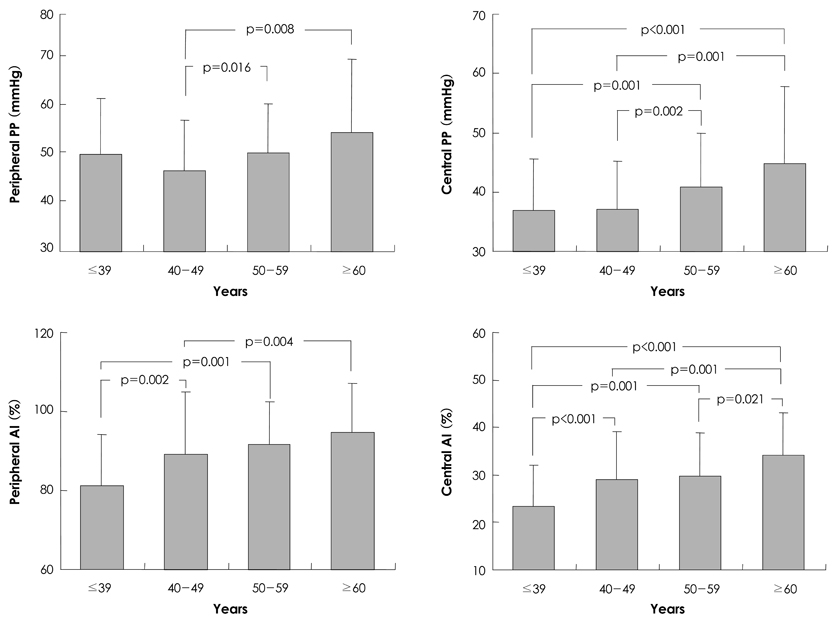Korean Circ J.
2010 Apr;40(4):165-171. 10.4070/kcj.2010.40.4.165.
Reference Values for the Augmentation Index and Pulse Pressure in Apparently Healthy Korean Subjects
- Affiliations
-
- 1Division of Cardiology, Daegu Catholic University Medical Center, Daegu, Korea. mdleeys@cu.ac.kr
- 2Division of Family Medicine, Daegu Catholic University Medical Center, Daegu, Korea.
- KMID: 2145552
- DOI: http://doi.org/10.4070/kcj.2010.40.4.165
Abstract
- BACKGROUND AND OBJECTIVES
Arterial stiffness is a precursor to premature cardiovascular disease. The augmentation index (AI) and pulse pressure (PP) are cardiovascular risk factors. The aim of this study was to define the diagnostic values of the AI and PP from the peripheral arterial and central aortic waveforms in healthy subjects. SUBJECTS AND METHODS: We recruited 522 consecutive subjects (mean age 46.3+/-9.6 years, 290 males) who came to our facility for a comprehensive medical testing. We measured the body mass index (BMI), blood pressure, peripheral and central PP, and a pulse wave analysis that included the central and peripheral AI. RESULTS: The peripheral and central AIs in the female subjects were significantly higher than that in the male subjects (p<0.001). The peripheral and central PPs in the subjects with hyperlipidemia were significantly higher than subjects with normal lipid profiles (p<0.001). The peripheral and central PPs and peripheral and central AIs significantly increased with age. CONCLUSION: Pending validation in prospective outcome-based studies, a peripheral PP of 70 mmHg, central PP of 50 mmHg, peripheral AI of 100%, and central AI of 40% may be preliminary values in adult subjects.
Keyword
MeSH Terms
Figure
Reference
-
1. Park HY, Lee SY, Cho SW, et al. Correlations between the left ventricular diastolic function and aortic stiffness in healthy aged subjects. Korean Circ J. 2006. 36:393–399.2. Chae CU, Pfeffer MA, Glynn RJ, Mitchell GF, Taylor JO, Hennekens CH. Increased pulse pressure and risk of heart failure in the elderly. JAMA. 1999. 281:634–639.3. Madhavan S, Ooi WL, Cohen H, Alderman MH. Relation of pulse pressure and blood pressure reduction to the incidence of myocardial infarction. Hypertension. 1994. 23:395–401.4. Fukui M, Kitagawa Y, Nakamura N, et al. Augmentation of central arterial pressure as a marker of atherosclerosis in patients with type 2 diabetes. Diabetes Res Clin Pract. 2003. 59:153–161.5. Lee YS, Kim KS, Hyun DW, et al. The change of arterial stiffness according to dialysis in patients with end-stage renal disease. Korean Circ J. 2004. 34:865–873.6. Domanski MJ, Mitchell GF, Norman JE, Exner DV, Pitt B, Pfeffer MA. Independent prognostic information provided by sphygmomanometrically determined pulse pressure and mean arterial pressure in patients with left ventricular dysfunction. J Am Coll Cardiol. 1999. 33:951–958.7. Cameron JD, McGrath BP, Dart AM. Use of radial applanation tonometry and a generalized transfer function to determine aortic augmentation in subjects with treated hypertension. J Am Coll Cardiol. 1998. 32:1214–1220.8. Wilkinson IB, Prasad K, Hall IR, et al. Increased central pulse pressure and augmentation index in subjects with hypercholesterolemia. J Am Coll Cardiol. 2002. 39:1005–1011.9. Benetos A, Safar M, Rudnichi A, et al. Pulse pressure: a predictor of long-term cardiovascular mortality in a French male population. Hypertension. 1997. 30:1410–1415.10. Franklin SS, Larson MG, Khan SA, et al. Does the relation of blood pressure to coronary heart disease risk changes with aging? The Framingham Heart Study. Circulation. 2001. 103:1245–1249.11. London GM, Blacher J, Pannier B, Guerin AP, Marchais SJ, Safar ME. Arterial wave reflections and survival in end-stage renal failure. Hypertension. 2001. 38:434–438.12. Lee JW. Pulse pressure and systolic blood pressure. Korean Circ J. 2002. 32:293–298.13. Agabiti-Rosei E, Mancia G, O'Rourke MF, et al. Central blood pressure measurements and antihypertensive therapy: a consensus document. Hypertension. 2007. 50:154–160.14. Adji A, Hirata K, Hoegler S, O'Rourke MF. Noninvasive pulse waveform analysis in clinical trials: similarity of two methods for calculating aortic systolic pressure. Am J Hypertens. 2007. 20:917–922.15. Nürnberger J, Keflioglu-Scheiber A, Opazo Saez AM, Wenzel RR, Philipp T, Schäfers R. Augmentation index is associated with cardiovascular risk. J Hypertens. 2002. 20:2407–2414.16. O'Rourke MF, Gallagher DE. Pulse wave analysis. J Hypertens Suppl. 1996. 14:S147–S157.17. Wilkinson IB, Cockcroft JR, Webb DJ. Pulse wave analysis and arterial stiffness. J Cardiovasc Pharmacol. 1998. 32:Suppl 3. S33–S37.18. Gatzka CD, Kingwell BA, Cameron JD, et al. Gender differences in the timing of arterial wave reflection beyond differences in body height. J Hypertens. 2001. 19:2197–2203.19. Waddell TK, Dart AM, Gatzka CD, Cameron JD, Kingwell BA. Women exhibit a greater age-related increase in proximal aortic stiffness than men. J Hypertens. 2001. 19:2205–2212.20. Hayward CS, Kelly RP. Gender-related differences in the central arterial pressure waveform. J Am Coll Cardiol. 1997. 30:1863–1871.21. Wilkinson IB, Cockcroft JR. Cholesterol, endothelial function and cardiovascular disease. Curr Opin Lipidol. 1998. 9:237–242.22. Nichols WW, O'Rourke MF, Avolio AP, et al. Effects of age on ventricular-vascular coupling. Am J Cardiol. 1985. 55:1179–1184.23. Cheitlin MD, Zipes DP. Braunwald E, Zipes DP, Libby P, editors. Cardiovascular disease in the elderly. Heart Disease. 2001. 6th ed. Philadelphia: WB Saunders.24. Nichols WW, Singh BM. Augmentation index as a measure of peripheral vascular disease state. Curr Opin Cardiol. 2002. 17:543–551.25. Asmar R, Vol S, Brisac AM, Tichet J, Topouchian J. Reference values for clinic pulse pressure in a nonselected population. Am J Hypertens. 2001. 14:415–418.26. Mitchell GF, Parise H, Benjamin EJ, et al. Changes in arterial stiffness and wave reflection with advancing age in healthy men and women. The Framingham Heart Study. Hypertension. 2004. 43:1239–1245.27. Wojciechowska W, Staessen JA, Nawrot T, et al. Reference values in white Europeans for the arterial pulse wave recorded by means of the ShygmoCor device. Hypertens Res. 2006. 29:475–483.28. Shiburi CP, Staessen JA, Maseko M, et al. Reference values for SphygmoCor measurements in South Africans of African ancestry. Am J Hypertens. 2006. 19:40–46.29. Li Y, Staessen JA, Li LH, Huang QF, Lu L, Wang JG. Reference values for the arterial pulse wave in Chinese. Am J Hypertens. 2008. 21:668–673.
- Full Text Links
- Actions
-
Cited
- CITED
-
- Close
- Share
- Similar articles
-
- Pulse wave velocity and ankle brachial index in normal adolescents
- Pulsatile Ocular Blood Flow in Healthy Koreans
- Association between Pulse Pressure and Carotid Intima-Media Thickness in Healthy Adolescents: Jangseong High School Study
- Effects of Acute Resistance Exercise on Arterial Stiffness in Young Men
- Changes of the Blood Pressure and the Rulse Rate of the Rat after the Noise Exposure

